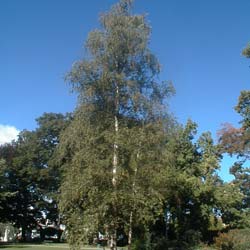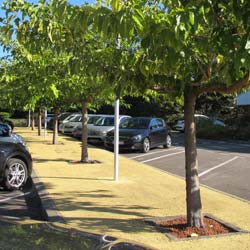Working the soil in winter
• Planting periods
• Storing Plants prior to Planting
• Planfor's perforated 1-litre Pots
• Soil Preparation
• Working the soil in winter
• Growing seeds in a pot
• Raising seedlings
• Planting Directly into the Soil
• Planting in Pots, Containers or Planters
• The good drainage for potted plants
• Planting Balled or container grown plants
• Planting bare rooted plants
• Planting Truffle Trees
• Planting Agapanthus
• Planting spring-flowering bulbs in pot
• Planting Fern in pot
• Planting a hedge of ornamental grasses
• Planting hardy plants in the autumn
• Succeeding in planting conifers
• Repotting a plant
• Propagate and increase plants by layering
• Moving a tree or shrub
• Plant a Magnolia
• Planting a tree which is going to grow quite tall
• Planting a hedge of bamboos
• Planting a fruit tree
• Potted plants which last a long time
Classic winter-task in a traditional garden, working the soil is sometimes useful… and sometimes not. Do not tire yourself out unnecessarily, but do not forget to do it if your ground lends itself to it.
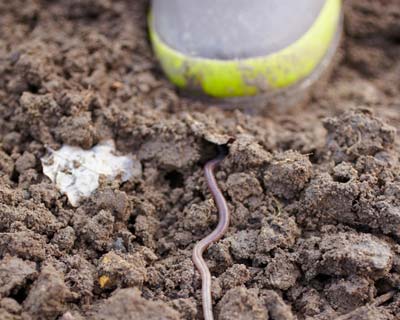
Worms are more active in a soil that breathes well.
How to determine if working the soil is necessary or not
If you soil is going to become waterlogged during winter, you must do whatever is necessary for the water to run through it. Otherwise plants’ roots are going to suffer from asphyxia.
Cases where it is not essential:
- Sandy, light soil;
- Soil mulched all year round;
- Soil which has superficial roots nearby;
- Flowering beds and borders planted with perennials or shrubs (it is best to use ground-covers or mulch!);
- Window-boxes and planters.
Cases in which working the soil is really useful:
- A clayish, very sticky soil;
- A soil which needs to be enriched (ballast/backfill);
- Plantations planned in a particular space (hedge, border, flowering bed);
- A soil which has suffered from subsidence (from the passage of building site machinery for example);
- A soil which is subjected to inundations.
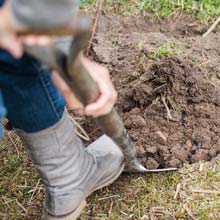
In the site chosen for the future plantations, loosen up the soil right now.
To sum up, it is essentially a clayish soil that needs working or a soil in which plantations are going to take place in the next few weeks!
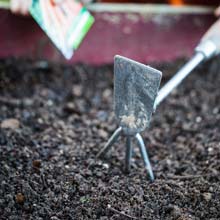
A soil worked in winter is quickly ready at sowing time in the spring!
How to prepare the soil
In winter, there is no need to be putting in the finishing touches. All that’s needed is to loosen up the soil, forming large clods, without breaking it up or raking it. The rain and the frost will do the rest while you wait for spring. It is just before planting out that the finishing jobs take place, in March for example, or even later.
How to work the soil?
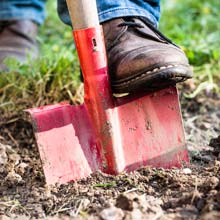
With a spade : it is physically harder but more effective. Prefer a garden fork or digging fork, a tiller even if you have large grounds.
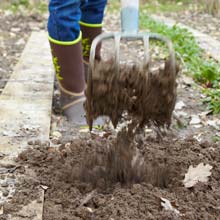
With a curved fork : for the soils which have already been worked in the past, this tool is used to lift up the clumps. It is used going forward and not backward.
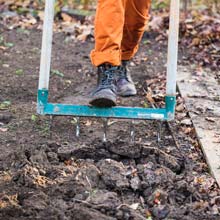
An ecological fork : it allows you to lift large clumps of soil without too much effort. You progress moving backwards. A little time to adapt is necessary to know how to use it well. It is not suitable for heavy soils.
Manure, soil-enriching agent, what to add and when?
In light soil, wait until the end of winter. The more the soil-enriching agent is fine and broken down, the later it needs to be added to the soil. Consequently, you can spread out fresh manure as from now, but wait until the end of winter for mature compost.
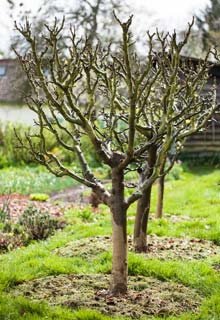
Fruit trees: bare roots is best
In winter, it is best to let the soil bare under fruit trees as the rain seeps into the soil more easily and the risk of roots ‘asphyxia is lower. Hoe or move the soil about using a hoe, a weeding hoe or a bent fork so as to lift up the grass and clear the soil. There is no need to remove all the grass but to lay the roots bare, in large clumps. Proceed all around the trunk, on a circumference of at least 1m, taking care not to damage the roots running near the surface. Let the grass grow again at the end of winter.




































